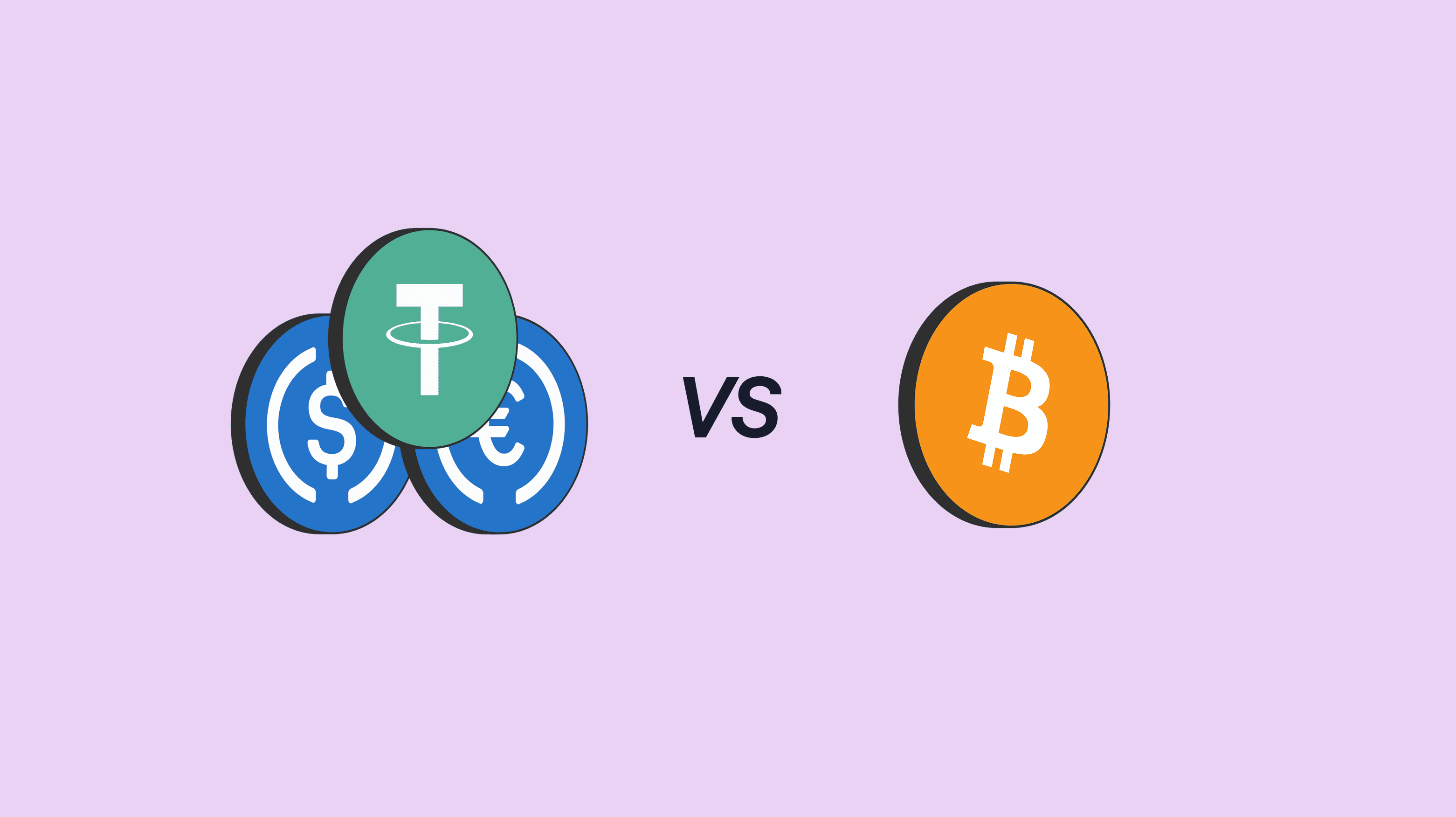
Stablecoins vs Bitcoin: Major Differences Explained
When you look at stablecoins and Bitcoin side by side, the contrast is striking. Stablecoins stick close to traditional currencies like the US dollar or Euro, keeping their value steady, something that matters a lot when you're actually trying to pay for things using blockchain technology. Today, they're worth about $263 billion as of mid-2025, but who knows where that will be by the time you read this article.
At Due, our mission is to help businesses move money globally in ways that are faster, smarter, and cheaper. In this article, we'll look more closely at two cryptocurrencies that everyone is talking about, Bitcoin and stablecoins. Both of these digital currencies exist outside of traditional banks, and they can move funds globally at lightning speed. However, they have both been established for two very different purposes.
Key Differences at a Glance
Bitcoin and stablecoins are both considered cryptocurrencies; however, they serve different purposes. Here is a quick overview of their key differences:
- Price Stability vs Volatility: Stablecoins do exactly what their name suggests; they stay stable by being pegged to an external asset (typically 1:1 to the US dollar), which supports consistency in price. Meanwhile, over the past year alone, Bitcoin’s value has fluctuated from a high of around $120,000 to various lows, demonstrating significant volatility, and with that sort of price movement, it can be hard to price your own product or pay suppliers with any real confidence.
- Centralized Issuer vs Decentralized Network: Most major stablecoins use a company or financial institution as an issuer and a reserve asset to support the value. Bitcoin does not have any one company or person in charge. It operates on a global network of computers that follow its built-in code rules.
- Multiple Networks vs Single Blockchain: Stablecoins operate across different blockchains, which makes them versatile and interoperable between different networks. Bitcoin is intended to operate on its own blockchain, but improvements like the Lightning Network are helping it operate across more spaces.
How Are Payment Leaders Using Stablecoins?
Leading payment companies and financial institutions have started adopting stablecoins to improve their services. The reason is simple: it can make moving money faster, cheaper, and more efficiently on a global scale. For example, they have been used for cross-border payments, which have both reduced costs from remittance fees of ~6–8% down to under 1%, and cut transaction times from days to mere minutes.
Stablecoin transaction volumes hit $27.6 trillion in 2024, outpacing the combined volumes of Visa and Mastercard by 7.7%. This massive figure shows how blockchain-based payments have quietly become a major force in global finance, handling more value than the world's biggest traditional payment networks.
Major payment processors have begun piloting stablecoin settlements – for instance, Visa has been settling transactions in USD Coin (USDC) for cross-border payments. Fintech firms are also utilising stablecoins to enable instant payouts in multiple countries without relying on slow bank wires. Unlike Bitcoin, whose price fluctuations pose a risk, stablecoins provide the predictability that finance teams prefer for day-to-day operations.
Types of Stablecoins Explained
What is a stablecoin? It can be defined as a cryptocurrency that is intended to hold a consistent value over time. To hold its value, the price is pegged to a reference asset, usually a fiat currency such as the US dollar. This is also why they are often described as crypto tokens backed with some sort of asset or currency held in reserve. Because blockchain-based assets are, in particular, meant to hold a price, their issuers rely on different mechanisms to put a safeguard around their worth:
- Fiat-Backed: These stablecoins are backed by traditional currency reserves at a 1:1 basis (e.g., one US dollar in reserves for each US dollar issued). Popular examples of fiat-backed payment tokens are USDT (Tether) and USDC (USD Coin), as these are backed by meaningful USD reserves.
- Commodity-Backed: Stablecoins are backed by physical commodities such as gold. The issuer typically owns the commodity (e.g., gold bars) and issues tokens that act as rights to that commodity.
- Crypto-Backed: Represent payment tokens collateralized by other cryptocurrencies. DAI is one example of a digital currency backed by crypto deposits (such as Ether) in smart contracts. Since the crypto collateral can be volatile, USD-pegged digital assets backed with crypto collateral are often over-collateralized to absorb spikes in crypto prices.
Algorithmic: These are not backed by an asset, but rather utilise an algorithm to manage supply and demand in order to stabilize the price. They can increase or decrease the coin supply in response to the market price, and hope to maintain the peg. (The design is experimental and has led to some notable failures in extreme market conditions).
Why Businesses Choose Stablecoins for B2B Payments in 2025
Stablecoins emerged as the most dominant cryptocurrency in business-to-business (B2B) payments, surpassing Bitcoin in volume and usability. They have been integrated swiftly into financial operations due to their unit of account consistency, usability on existing infrastructure, and regulatory clarity. The transactional volume is arguably the most definitive proof of their adoption.
In 2025, numerous businesses are switching to stablecoins over Bitcoin for B2B payments due to volume, stability, and integration:
- Stablecoin’s growth has picked up serious momentum in recent years. McKinsey found that stablecoin circulation has doubled from $120 billion to $250 billion in just 18 months, with these digital tokens now facilitating $20 to $30 billion in real payment transactions every day. The consulting firm projects this could reach $400 billion by the end of this year, though current daily transaction volumes still represent less than 1% of global money flows compared to traditional payment networks.
Here are the top reasons companies are choosing stablecoins over Bitcoin for payments:
- 1:1 Fiat Peg: The US dollar-pegged tokens (USDC, USDT, etc.) have removed the price volatility, since one is designed to equal $1.
- Multi-Chain Support: This includes stablecoins on other networks such as Solana and Tron, allowing businesses to pick fast, cheap, and reliable networks.
- Seamless Integration: They seem to businesses like a digital version of the dollar that they can easily use, and they can easily be integrated into invoicing systems, ERPs, and even treasury operations.
Regulatory Clarity: Recent laws in the US (GENIUS Act), the European Union (MiCA), and the United Kingdom legal frameworks require issuers to maintain at least full reserves, audit coverage, and transparency of reserves, giving businesses more assurance.
Integrating Stablecoins with Due's Payment Platform
Stablecoins are changing the face of B2B payments; they're becoming a more controlled, speedier, and compliant alternative to Bitcoin for the normal individual business transaction. Due, which was designed as a global payment platform that supports stablecoin integration, has connected directly into this opportunity, allowing businesses to:
- Manage their payment token holdings and cross-border transactions from one API.
- Open virtual accounts in USDC, EURC, GBP, and local currencies in 80+ regions.
- Connect your Web3 wallets through our interface, KYC/KYB compliance, and manage all real-time FX rates.
When Due linked traditional invoicing processes to blockchain rails, it offered enterprises all the operational stability of fiat, without losing any of the speed and lower cost of stablecoins.
Are you ready to expose your company's payment stack to crypto, without the risk? Learn more about our coverage, supported currencies, and payment services with Due here.
FAQ — Stablecoins vs Bitcoin
Are stablecoins better than Bitcoin?
This will depend on its intended application. Stablecoins and Bitcoin are designed for different uses. Generally speaking, where stability is a must for payments and transactions, stablecoins are preferable as far as they allow. They are vastly superior for day-to-day transactions due to predictable pricing; one doesn’t have to be concerned about a big price change during the course of agreeing or negotiating payment for a business transaction. They provide the speed and efficiency of crypto, with the stable value of fiat currency. They can also be superior for B2B settlements, remittances, and trading with zero risk of currency fluctuations. Bitcoin could be superior when investing for the long term, or as a "store of value" hedge for long-term investments against inflation or any depreciation in currency value. Also, its short-term volatility is a functional limitation to using it to make daily transactions. Simply put, for transactional use with immediacy, stablecoins are better, while Bitcoin is selected for long-term growth potential and decentralization.
Is Bitcoin a stablecoin?
No, Bitcoin is not a stablecoin. Although it is a cryptocurrency, it was not designed to maintain a stable value. A stablecoin tries to maintain value by valuing it against something similar or stable, which could include a currency (e.g., USD) or a commodity (e.g., gold), to try to make one coin = equal $1. Bitcoin, by contrast, was meant to be priced based on supply and demand, market caps, and the price was meant to change. A part of this is that Bitcoin can often react quickly to market sentiment and many other factors.
What is the difference between stablecoins and other cryptocurrencies?
Stablecoins are a form of cryptocurrency. In general, they have a value that is stable, unlike other cryptocurrencies such as Bitcoin and Ethereum, which have highly volatile prices. In essence, stablecoins want to bring together the best of both worlds: they use blockchain technology, which can be sent instantly like other cryptocurrencies, and have their value based on stability, so they don’t have the same volatility associated with price changes. All other cryptoassets (sometimes referred to as “altcoins” or just crypto in general ) are not typically pegged to other asset classes, so these prices fluctuate wildly according to buyers and sellers in the market. That is why the price stability shouldn’t be underestimated, as it makes it beneficial for payment transactions and user-friendly onramps to and from the crypto world to fiat currencies. At the same time, other cryptocurrencies are more suited to investment, utility in decentralized applications, or other speculative purposes.
Why do businesses prefer stablecoins over Bitcoin for day-to-day payments?
Stablecoins maintain a 1:1 peg to fiat (e.g., USD), reducing price risk at checkout and in B2B settlements, while supporting fast, low-cost transfers across multiple networks making reconciliation and pricing straightforward for finance teams.
How do regulations affect stablecoins vs. Bitcoin for corporate use?
Recent frameworks (e.g., GENIUS Act in the U.S., EU MiCA) push issuers toward full-reserve backing, disclosures, and oversight, giving stablecoins clearer operational guardrails than Bitcoin for treasury, payouts, and cross-border flows.





%20-%20Partnership%20-%20Due%20%2B%20Tempo%20-%20V1.png)